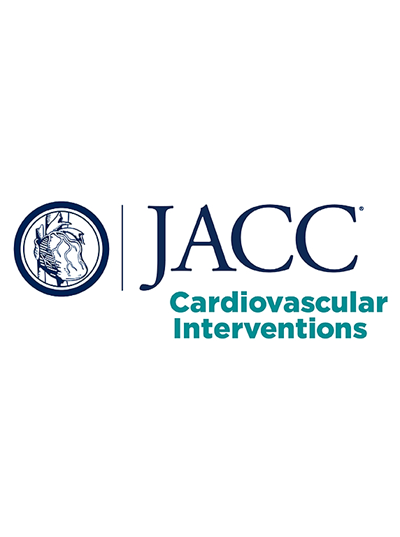Early Results of Multicenter Trial of a Novel Balloon-Expandable Valve With Anchor for Aortic Regurgitation
IF 11.7
1区 医学
Q1 CARDIAC & CARDIOVASCULAR SYSTEMS
引用次数: 0
Abstract
Background
The application of transfemoral transcatheter aortic valve replacement (TAVR) for patients with severe pure native aortic regurgitation (PNAR) is limited by a lack of dedicated devices. The Hanchor Valve system is the first transfemoral balloon-expandable transcatheter heart valve with an anchor element designed for PNAR.
Objectives
The aims of this report are to present the 30-day follow-up results of transfemoral TAVR using the Hanchor Valve system in patients with severe PNAR and to provide insights into the technical aspects of the procedure.
Methods
The HAVE AR (Multi-Center Trial of Hanchor Valve for Treating Patients With Severe Pure Native Aortic Regurgitation) trial is an ongoing, prospective, multicenter, single-arm, objective performance criteria registration study. Transfemoral TAVR using the Hanchor Valve system for treating severe PNAR was performed in patients with intermediate and high surgical risk. Procedural results and 30-day clinical and echocardiographic outcomes were collected and analyzed.
Results
A total of 128 patients were enrolled at 13 centers in mainland China, with a median age of 74 years (Q1-Q3: 70-78 years) and a median Society of Thoracic Surgeons Predicted Risk of Mortality score of 4.84% (Q1-Q3: 4.21%-6.47%). Procedural success was achieved in 123 of 128 patients (96.09%), with a median oversizing ratio of 5.10% (Q1-Q3: 2.69%-6.83%) and a median implantation depth of 5 mm (Q1-Q3: 2-6 mm). Valve migration occurred in 3 of 128 cases, with 2 of 128 patients undergoing second valve implantation and 1 of 128 converting to surgery. Within the 30-day follow-up, 15 of 125 patients (12.00%) required new permanent pacemaker implantation, 1 of 128 patients (0.78%) experienced a major bleeding event, and 3 of 128 patients (2.34%) died. At 30-day follow-up, none of the patients had intravalvular aortic regurgitation or more than mild paravalvular regurgitation. The median effective orifice area was 2.50 cm2 (Q1-Q3: 2.20-2.98 cm2). Significant improvements were observed in NYHA functional class (P < 0.001) and EQ-5D score (P < 0.001). Moreover, significant reductions were observed in left ventricular end-diastolic diameter (P < 0.001) and left ventricular end-systolic diameter (P < 0.001) at 30-day follow-up, while there was an increase in left ventricular ejection fraction (P = 0.007).
Conclusions
The early results of the HAVE AR trial showed a low incidence of adverse safety events, especially low permanent pacemaker implantation rate, and good efficacy of the Hanchor Valve system for treating patients with severe PNAR at intermediate or high surgical risk.
带锚点的新型球囊可膨胀瓣膜治疗主动脉反流的多中心试验的早期结果
经股经导管主动脉瓣置换术(TAVR)在严重纯原生主动脉瓣返流(PNAR)患者中的应用受到缺乏专用设备的限制。Hanchor瓣膜系统是第一个经股球囊扩张经导管心脏瓣膜,带有专为PNAR设计的锚定元件。本报告的目的是介绍使用Hanchor瓣膜系统对严重PNAR患者进行经股动脉TAVR的30天随访结果,并对该手术的技术方面提供见解。方法:hachor瓣膜治疗严重单纯原生主动脉瓣返流患者的多中心试验(HAVE AR)是一项持续、前瞻性、多中心、单臂、客观性能标准注册研究。采用Hanchor瓣膜系统经股骨TAVR治疗严重PNAR的患者为中、高风险患者。收集并分析手术结果和30天的临床和超声心动图结果。结果中国大陆13个中心共纳入128例患者,中位年龄为74岁(Q1-Q3: 70-78岁),胸外科学会预测死亡风险评分中位为4.84% (Q1-Q3: 4.21%-6.47%)。128例患者中123例(96.09%)手术成功,中位过径率5.10% (Q1-Q3: 2.69%-6.83%),中位植入深度5mm (Q1-Q3: 2- 6mm)。128例患者中有3例发生瓣膜移位,其中2例进行了第二次瓣膜植入,1例转为手术。随访30天,125例患者中有15例(12.00%)需要植入新的永久性起搏器,128例患者中有1例(0.78%)发生大出血,128例患者中有3例(2.34%)死亡。在30天的随访中,没有患者出现瓣内主动脉反流或轻度瓣旁反流。有效孔面积中位数为2.50 cm2 (Q1-Q3: 2.20-2.98 cm2)。NYHA功能评分显著改善(P <;0.001)和EQ-5D评分(P <;0.001)。此外,左室舒张末期内径明显减小(P <;0.001)和左心室收缩末期内径(P <;0.001),而左室射血分数升高(P = 0.007)。结论早期的研究结果显示,不良安全事件发生率较低,特别是永久性起搏器植入率较低,对于中、高手术风险的重度PNAR患者,Hanchor Valve系统具有良好的疗效。
本文章由计算机程序翻译,如有差异,请以英文原文为准。
求助全文
约1分钟内获得全文
求助全文
来源期刊

JACC. Cardiovascular interventions
CARDIAC & CARDIOVASCULAR SYSTEMS-
CiteScore
11.60
自引率
8.80%
发文量
756
审稿时长
4-8 weeks
期刊介绍:
JACC: Cardiovascular Interventions is a specialist journal launched by the Journal of the American College of Cardiology (JACC). It covers the entire field of interventional cardiovascular medicine, including cardiac, peripheral, and cerebrovascular interventions. The journal publishes studies that will impact the practice of interventional cardiovascular medicine, including clinical trials, experimental studies, and in-depth discussions by respected experts. To enhance visual understanding, the journal is published both in print and electronically, utilizing the latest technologies.
 求助内容:
求助内容: 应助结果提醒方式:
应助结果提醒方式:


